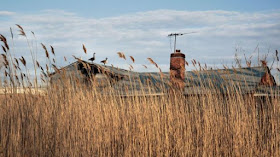Nature, of course, doesn’t have to wait. The marsh is growing back where demolished houses once stood, and it now forms a natural buffer between the town and the sea. As a result, Oakwood Beach has turned into an unplanned experiment in managed retreat, the idea that people should abandon the coasts and give hazardous coastal habitats back to nature. To some, retreat looks like the best option to keep people safe, especially as scientists doubt that seawalls are effective protection and concerns about rising seas grow.Photographer Hillary Eggers visits Oakwood Beach often, to take pictures of the evolution of the land, from suburbia to natural wetlands. You can see the progress at Audubon.
“Water will flow wherever it can; concrete walls, roads and houses will not stop it,” wrote Lisa Bova-Hiatt, the executive director of New York Governor Cuomo’s Office of Storm Recovery, in a statement to Audubon. “Managed retreat moves people and property out of harm’s way and allows the reestablishment of wetlands. The natural wetland buffer protects the upland communities and absorbs water, which it wasn’t able to do when the area was densely populated with homes.”
Friday, November 11, 2016
After Hurricane Sandy, One Neighborhood Gives Itself Back to Nature
The
Oakwood Beach area of Staten Island was once home to hundreds of
people. They endured floods and wildfires because they loved living on
the beach. But then hurricane Sandy blew through in 2012 and caused
untold damage. Since then, the state of New York has bought up 299 homes
so the residents could relocate, and only 12 families remain on Oakwood
Beach. The rest of the properties have been moving back to nature. Some
homes were leveled by the hurricane, some have since been demolished,
and some are just decaying on their own. The government plans a sea wall
project to begin in 2019.


No comments:
Post a Comment